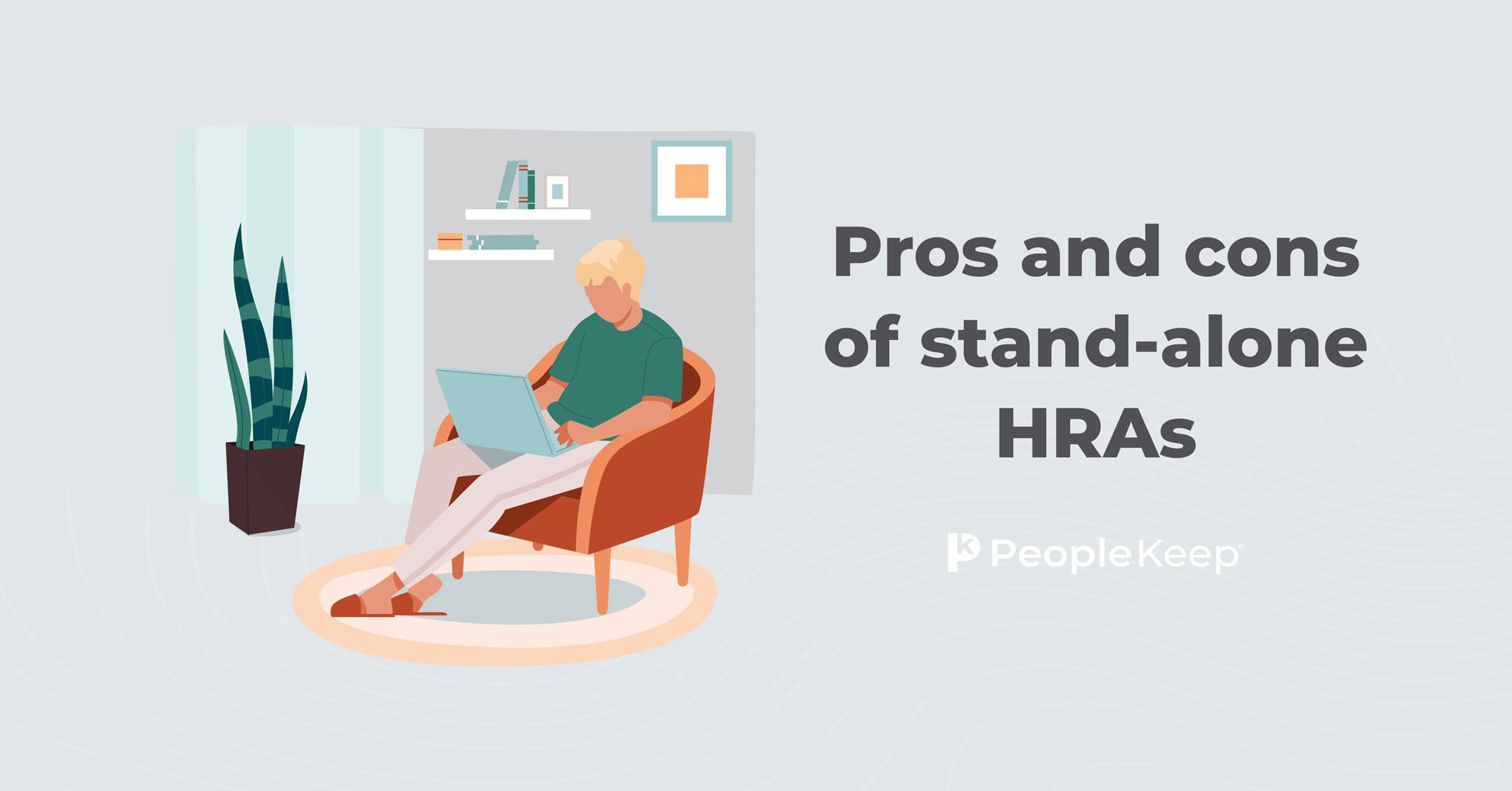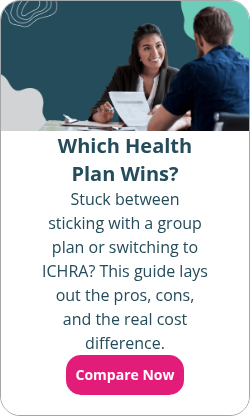How to make individual health insurance work for small employers
By Elizabeth Walker on July 16, 2025 at 9:00 AM
If you’re a small business owner who doesn’t offer an employer-sponsored health plan, your employees may decide to buy their own individual coverage. Your staff may like their policy’s provider network, covered services, and plan type. But as your business grows, you might decide it’s time to offer a more inclusive health insurance option.
Can small and medium-sized businesses provide a formal health benefit that allows their employees to keep their individual coverage? Yes, a defined contribution health plan, like a health reimbursement arrangement (HRA), is an excellent solution that lets you do just that.
This article will explain how to make individual health insurance work for your team and how an HRA can help you build a competitive benefits package.
In this blog post, you’ll learn:
- How individual health insurance can offer a more affordable and flexible alternative to traditional group health plans for small business employers.
- Why pairing individual coverage with an HRA gives employees more choice and control over their healthcare.
- What makes HRAs a great benefit option for supporting diverse workforces and managing costs.
Why does individual health insurance work as a health benefit option for small employers?
When paired with an HRA, individual health plans offer more affordability, flexibility, and personalization compared to traditional group health insurance.
A record-breaking 21.4 million Americans1 enrolled in a Marketplace plan during the 2024 Open Enrollment Period. While group health coverage has always been the traditional choice for insuring employees, many small business owners are abandoning it for individual plans to stabilize their company’s budget and put their employees in charge of their health.
Below are a few reasons individual health insurance is a good option for employees and employers, especially if you’re offering an HRA.
1. It’s often more affordable than traditional group health insurance
The cost of offering a group health plan has risen over the last several years, causing serious concern among employers, especially small business owners and nonprofit companies.
In 2024, the average group plan premium for a self-only plan was $8,951/year (or $746 monthly). Family coverage averaged $25,572/year (or $2,131 per month), with employers paying $19,276 of the annual cost2. These prices are unsustainable for many small employers, especially when insurers add minimum participation requirements into the mix.
In contrast, individual coverage is more flexible and often costs less. While prices vary based on location, the employee’s age, and other factors, the average premium for a benchmark Marketplace plan was $477 per month in 20243. Depending on their annual income, employees may also qualify for premium tax credits, making coverage even more affordable.
If you drop group health coverage and offer a cost-controlled HRA, your employees can choose their preferred individual health plan. At the same time, you avoid the costly premiums associated with small group health insurance.
2. It’s personalized to your employees’ needs
Besides being expensive, the one-size-fits-all structure of group health coverage is often too rigid to meet the unique needs of a modern workforce.
Group plans may offer limited carrier or network choices, resulting in employees having coverage that doesn’t work with their preferred doctors and pharmacies, or not having the right coverage for certain health conditions. Not only can this be frustrating and lower employee morale, but it can also lead to extra out-of-pocket costs, leaving them financially strapped.
With an HRA, each employee can buy the individual plan with a price and network that makes sense for them and their families. This personalized employee benefit is ideal for diverse workforces of varying ages and health conditions. HRAs can also support multi-state companies with remote workers, helping to boost employee satisfaction and retention.
3. You can reimburse individual health plan premiums with an HRA
With a group health plan, employees have to pay for any out-of-pocket costs that their policy doesn’t fully cover, in addition to their monthly premiums. By offering an HRA, your employees can receive reimbursements for their individual health premiums and more than 200 qualified medical expenses. Even better, HRA reimbursements are payroll tax-free for employers and free of income tax for employees.
Whether you have young employees who want coverage in case of an emergency or older employees who visit the doctor more frequently, reimbursing your employees for their individual health coverage and other medical costs allows all of them to get the care they need.
How do HRAs work alongside individual health insurance?
As mentioned above, an HRA is a tax-advantaged health benefit that enables employers to reimburse employees for qualified medical care expenses. Some HRAs, like integrated HRAs, only work with group health coverage. But two HRAs don’t coordinate with group health insurance plans. These stand-alone HRAs can support small businesses wanting to leverage a cost-effective health benefit that works with individual health coverage.
Here’s how a stand-alone HRA works for small businesses:
- You give your employees a monthly amount of tax-free money to help cover their medical costs. Depending on the stand-alone HRA you choose, there may be limits on how much allowance you can offer and the maximum size your company can be.
- Then, your team shops for individual health insurance on a public or private insurance exchange. They can also use their HRA money on other eligible medical expenses listed in IRS Publication 5024. In 2020, the CARES Act expanded the list to include even more items5. But you can choose to limit reimbursements to health insurance premiums only.
- Lastly, employees pay their medical expenses upfront and submit claim documentation of the cost to you or your HRA administrator. Once you approve the claim, you reimburse them tax-free up to their monthly allowance limit. Any unused funds stay with your business if the employee leaves your company or at the end of the plan year.
Next, we’ll review the two stand-alone HRAs that can work for small businesses.
Qualified small employer HRA (QSEHRA)
The QSEHRA is for employers with fewer than 50 full-time equivalent employees (FTEs) who don’t offer group health coverage. If you have at least one W-2 worker, you can use this HRA to reimburse them for individual health insurance and other medical costs instead of opting for a traditional small business health plan.
Below is a quick overview of how the QSEHRA can support your workforce:
- There are no minimum contribution requirements, but the IRS does set annual maximums for the QSEHRA. You can vary allowance amounts based on age or family status.
- You must offer the QSEHRA to all full-time W-2 employees. To be more inclusive, you can include part-time workers in the benefit. But they must receive the same allowance amount as your full-time employees. Some business owners may also qualify to participate.
- Enrolled employees must have a health plan that meets minimum essential coverage (MEC) to use the benefit, such as an ACA-compliant individual plan, Medicare, Medicaid, or group coverage through a spouse or parent.
- Employees eligible for premium tax credits can still receive their subsidies if their QSEHRA allowance isn’t affordable. But their allowance will reduce the number of credits they may collect.
- You can choose to reimburse premiums only to ensure employees are using their full allowances for health and ancillary coverage. You can also reimburse employees for out-of-pocket medical expenses.
Individual coverage HRA (ICHRA)
The ICHRA is another stand-alone option for businesses of all sizes, including small employers. Like the QSEHRA, it allows you to help employees pay for individual health insurance and qualified medical expenses. But it offers more flexibility and customization options.
Here are a few key ways the ICHRA can work for business owners:
- The ICHRA has no caps on how much allowance you can offer your employees. If needed, you can change your contribution amount during the plan renewal period.
- You can set different eligibility rules and allowances using employee classes, like full-time vs. part-time, location, age, or family size. This allows you to craft a custom benefit that your staff will find valuable. And, like the QSEHRA, you can also differ allowances by age and family status.
- Employees must have qualified individual health coverage to participate in the benefit and receive reimbursements. This means employees on a spouse’s or parent’s group plan can’t participate unless they enroll in an individual policy.
- Employees can collect premium tax credits depending on affordability. Suppose your ICHRA’s allowance is affordable. In that case, qualifying employees should waive their ACA tax credits and opt into the benefit. They can opt out of the ICHRA and continue receiving their credits if it's not affordable.
- If they opt out of the ICHRA and their allowance is affordable, they can’t collect their premium tax credits.
Not all small businesses stay small. If your company grows to the size of an applicable large employer (ALE) — or a business that employs more than 50 FTEs — you can use the ICHRA to satisfy the ACA’s employer mandate.
Conclusion
Offering health benefits as a small employer can feel like an uphill battle, filled with high costs and headaches. Thankfully, individual health insurance paired with an HRA allows small businesses to offer flexible, affordable coverage without needing a one-size-fits-all group plan. While a reimbursement model is a shift in how employers traditionally provide health benefits, making the change can be worth it for you and your employees
Reimbursing your employees for their individual health insurance is easier than you’d think, especially if you partner with PeopleKeep by Remodel Health. We can help you design and manage your personalized health benefit in minutes each month, and our award-winning customer support team is here to help you every step of the way.
This article was originally published on August 14, 2015. It was last updated July 16, 2025.
1. Health insurance marketplaces 2024 open enrollment report
2. 2024 Employer Health Benefits Survey
3. Average Marketplace Premiums by Metal Tier
5. CARES Act
Check out more resources
See these related articles

What is the family glitch, and is it fixed?
Curious about the Family Glitch and its impact on your healthcare coverage? Find out everything you need to know.

Pros and cons of stand-alone HRAs
Stand-alone HRAs can offer flexibility and control over healthcare expenses, allowing employers to customize plans to meet their employees' needs.

How HRAs affect premium tax credit eligibility
Learn how to coordinate tax credits with two of the most popular HRAs: the qualified small employer HRA (QSEHRA) and the individual coverage HRA (ICHRA).



